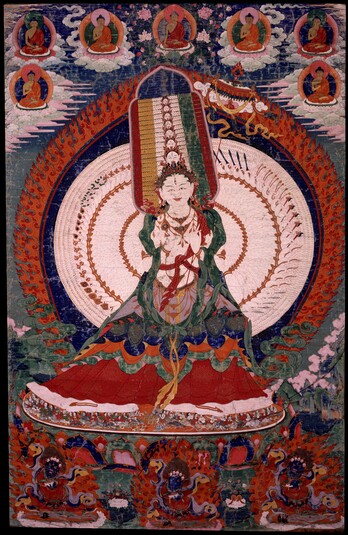
Item: Sitatapatra (Buddhist Deity) - (1000 faces, 1000 hands)
| Origin Location | Tibet |
|---|---|
| Date Range | 1700 - 1799 |
| Size | 144.78x94.62cm (57x37.25in) |
| Material | Ground Mineral Pigment on Cotton |
| Collection | The Brooklyn Museum of Art |
| Catalogue # | acc. #BMA 84.188, Gift of Mr. Orrin M.C. Hein in Memory of Eleanor Olson |
Classification: Deity
Appearance: Semi-Peaceful
Gender: Female
Sitatapatra, Vajra Ushnisha (Tibetan: do rje tsug tor dug kar mo. English: The White Parasol One of the Vajra Crown Protuberance [of the Buddha]).
Sanskrit: Sitatapatra Tibetan: Dug kar mo
Tibetan: Dug kar mo
White in colour with 1000 faces, 1000 hands, 1000 legs and 10,100,000 (ten million one hundred thousand) eyes. The main face in front is white with 199 white faces above, to the left is a vertical row of yellow faces, to the right is a vertical row of green faces, on both sides are red faces and on top of those are 200 more blue faces. Each face has three eyes and each set of coloured faces displays a different expression. In the first pair of hands the right holds a Dharma Wheel in the Refuge Giving mudra (gesture) and the left holds an arrow together with the handle of a parasol, held to the heart, unfurled above on the right side. She is adorned with various jewel ornaments and wears upper and lower silk garments of assorted colours.
A further 99 pairs of hands hold in the right a Dharma Wheel and an arrow in the left. The remaining 400 hands on the right hold a vajra, jewel, lotus and visvavajra (double vajra), 100 of each object. The remaining 400 hands on the left hold a bow, sword, lasso and hook, again 100 of each object. The 500 legs on the left side are extended above worldly deities and a host of animals and the legs on the right are bent and press down on all worldly troubles, daemons and animals. All the limbs and parts of her body are covered with large staring eyes. She stands upon innummerable sentient beings atop a multicoloured lotus seat and is completely surrounded by the flames of pristine awareness.
Along the top are the 7 Buddhas of this age and at the bottom are the Three Mahakalas (Tib.: gon po che sum), brothers, and identical in appearance.
Jeff Watt 3-2002
Buddhist Deity: Deities (Female)
Buddhist Deity: Sitatapatra Main Page
Collection of Brooklyn Museum of Art
Collection of Brooklyn Museum of Art (Deities)
